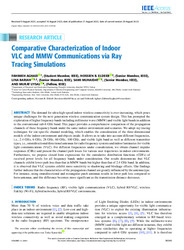Comparative characterization of indoor VLC and MMW communications via ray tracing simulations
| dc.contributor.author | Hosseinabadi, Fahimeh Aghaei | |
| dc.contributor.author | Eldeeb, H. B. | |
| dc.contributor.author | Bariah, L. | |
| dc.contributor.author | Muhaidat, S. | |
| dc.contributor.author | Uysal, Murat | |
| dc.date.accessioned | 2023-10-30T10:27:17Z | |
| dc.date.available | 2023-10-30T10:27:17Z | |
| dc.date.issued | 2023 | |
| dc.identifier.issn | 2169-3536 | en_US |
| dc.identifier.uri | http://hdl.handle.net/10679/8899 | |
| dc.identifier.uri | https://ieeexplore.ieee.org/document/10225534 | |
| dc.description.abstract | The demand for ultra-high-speed indoor wireless connectivity is ever-increasing, which poses unique challenges for the next generation wireless communication system design. This has prompted the exploration of higher frequency bands including millimeter wave (MMW) and visible light bands in addition to the conventional sub-6 GHz band. This paper provides a comprehensive comparison of the propagation channels of these frequency bands under the same indoor environment and scenarios. We adopt ray tracing techniques for site-specific channel modeling, which enables the consideration of the three-dimensional models of the indoor environment and objects inside. It allows us to take into account different frequencies, i.e., 2.4 GHz, 6 GHz, 28 GHz, 60 GHz, 100 GHz, and visible light band as well as different transmitter types, i.e., omnidirectional/directional antennas for radio frequency systems and indoor luminaries for visible light communications (VLC). For different frequencies under consideration, we obtain channel impulse responses (CIRs) and present the channel path losses for various user trajectories in indoor environments. Furthermore, we propose closed-form expressions for the cumulative distribution functions (CDFs) of received power levels for all frequency bands under consideration. Our results demonstrate that VLC channels exhibit lower path loss than that in MMW bands but higher than that of 2.4 GHz band. In addition, it is observed that VLC systems exhibit more sensitivity to shadowing and blockage effects. Our findings further indicate that the characteristics of the propagation channel are greatly influenced by the antenna type. For instance, using omnidirectional and rectangular patch antennas results in lower path loss compared to horn antennas, and this difference becomes more significant as the transmission distance decreases. | en_US |
| dc.language.iso | eng | en_US |
| dc.publisher | IEEE | en_US |
| dc.relation.ispartof | IEEE Access | |
| dc.rights | Attribution-NonCommercial-NoDerivs 4.0 International | * |
| dc.rights | openAccess | |
| dc.rights.uri | https://creativecommons.org/licenses/by-nc-nd/4.0/ | * |
| dc.title | Comparative characterization of indoor VLC and MMW communications via ray tracing simulations | en_US |
| dc.type | Article | en_US |
| dc.description.version | Publisher version | en_US |
| dc.peerreviewed | yes | en_US |
| dc.publicationstatus | Published | en_US |
| dc.contributor.department | Özyeğin University | |
| dc.contributor.authorID | (ORCID 0000-0001-5945-0813 & YÖK ID 124615) Uysal, Murat | |
| dc.contributor.ozuauthor | Uysal, Murat | |
| dc.identifier.volume | 11 | en_US |
| dc.identifier.startpage | 90345 | en_US |
| dc.identifier.endpage | 90357 | en_US |
| dc.identifier.wos | WOS:001058765600001 | |
| dc.identifier.doi | 10.1109/ACCESS.2023.3307186 | en_US |
| dc.subject.keywords | Hybrid networks | en_US |
| dc.subject.keywords | Hybrid RF/VLC | en_US |
| dc.subject.keywords | Hybrid RF/VLC environments | en_US |
| dc.subject.keywords | Radio frequency (RF) | en_US |
| dc.subject.keywords | Visible light communication (VLC) | en_US |
| dc.subject.keywords | Wireless fidelity (Wi-Fi) | en_US |
| dc.identifier.scopus | SCOPUS:2-s2.0-85168753233 | |
| dc.contributor.ozugradstudent | Hosseinabadi, Fahimeh Aghaei | |
| dc.relation.publicationcategory | Article - International Refereed Journal - Institutional Academic Staff and PhD Student |
Files in this item
This item appears in the following Collection(s)
Share this page




